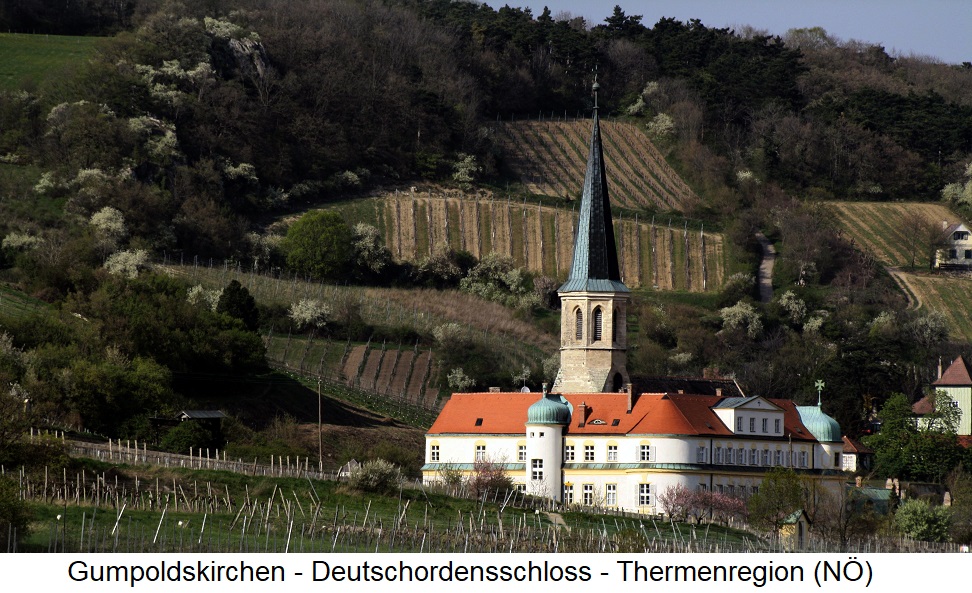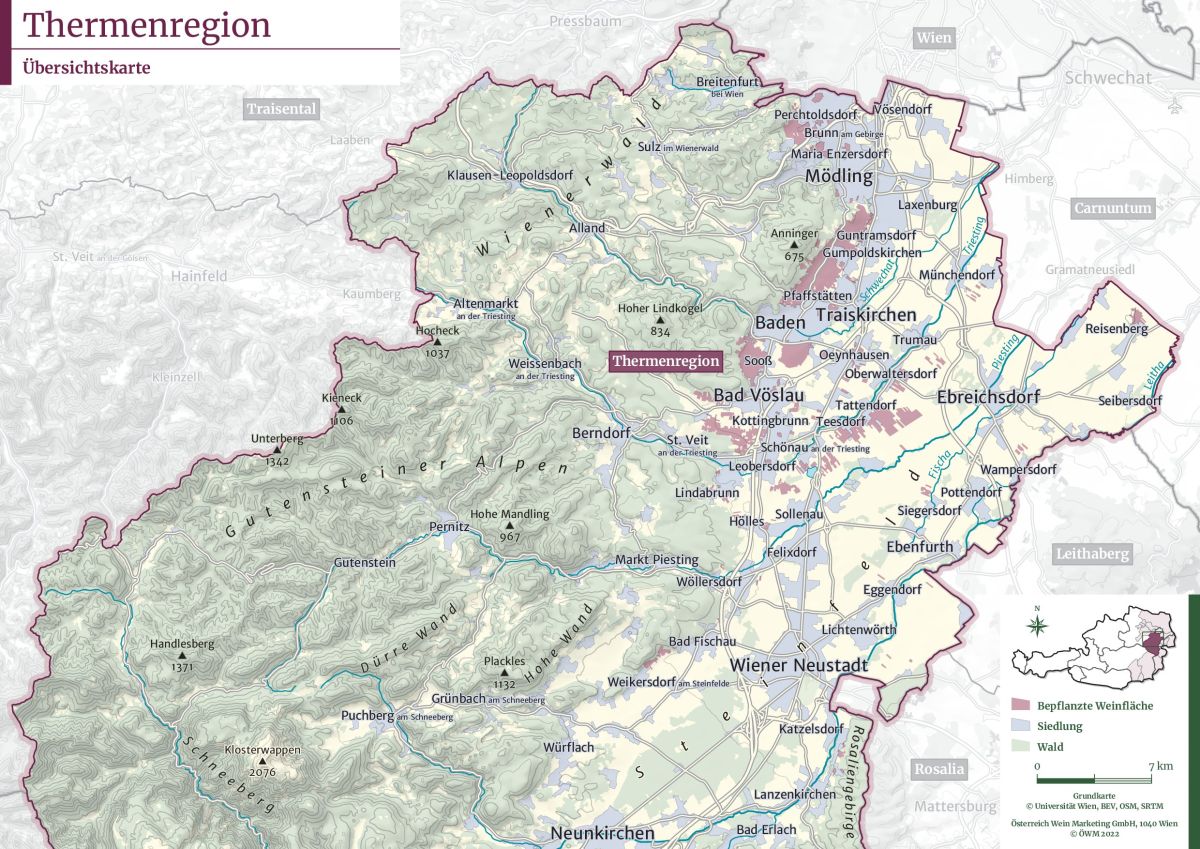Since the 2021 vintage, DAC area defined by wine law (specific winegrowing area) in the Austrian winegrowing region of Lower Austria (generic winegrowing area). See at Thermenregion.
Thermenregion
One of the eight specific wine-growing areas in the Austrian province or generic wine-growing region of Lower Austria. It was formed in 1985 by merging the formerly independent wine-growing areas of Gumpoldskirchen and Bad Vöslau. The thermal baths, already known in ancient times, gave the area its name, but in the vernacular it is called "Südbahn" after the railway line built here in the mid-19th century. The area extends from the southern outskirts of the Austrian capital Vienna along a chain of hills to the south of the spa town of Baden.

History
Austria's oldest vineyard, the Stiftsweingut Heiligenkreuz - Freigut Thallern near Gumpoldskirchen was founded in 1141 by the Cistercians of Heiligenkreuz Abbey. Since the 13th century, the right to serve wine, known as Leitgeben (Leutgeben), has been a tradition. There were rich wine yields in the 14th and 15th centuries. In the 16th and 17th centuries the area was badly affected by the Turkish sieges. The Turkish commander-in-chief Kara Mustapha (1630-1683), who fell ill during the second Turkish siege of Vienna, recovered very quickly in Baden in 1683. Viticulture suffered the heaviest losses because the Turks destroyed many vineyards for religious reasons. In 1760, the Pinot Noir was introduced to the area by the Teutonic Order and began to spread throughout the region into Burgenland. The area is part of the Vienna Basin and is one of the warmest wine-growing regions in Austria. Hugo von Hofmannsthal (1847-1929), the creator of "Everyman", described it as an "immense garden".

Climate & Soils
The climate is characterised by dry, hot summers and cold winters. Loamy soils of fine-grained sediments predominate. The often high coarse content is due to consolidated or loose gravels and sands with a high lime content and many remains of mussels, snails and other marine life. Debris-containing slope foot deposits provide drainage and through-warming. In the Steinfeld, poor gravel soils provide excellent conditions for red wine varieties.
Wine-growing communities
A beautiful wine route touches all the important wine-growing communities. The most important are Baden, Bad Vöslau, Brunn am Gebirge, Enzesfeld, Gumpoldskirchen, Guntramsdorf, Hirtenberg, Leobersdorf, Maria Enzersdorf, Mödling, Perchtoldsdorf, Pfaffstätten, Sooß, Tattendorf, Teesdorf, Traiskirchen and Tribuswinkel. Well-known vineyards are Brindlbach, Doctnerin, Eichkogel, Goldeck, Igeln, Kreuzer, Mandelhöhe, Pfarrgarten, Spiegel, Tümpfel and Wiegen.
Grape variety list
In 2022, the vineyards covered a total of 1,872 hectares of vines. Compared to 2015 with 2,196 hectares, this was a reduction of 324 hectares (14.7%). The share of red wine varieties is 57%, the share of white wine varieties 43%. A local speciality is the autochthonous variety Zierfandler (Spätrot), which is blended with the Rotgipfler to create the white wine cuvée Spätrot-Rotgipfler. A number of wine tourism activities are carried out under the name "Zierfandler-Welt". The red wine variety Zweigelt dominates, followed by Grüner Veltliner, St. Laurent, Blauer Burgunder and Rotgipfler.
Grape variety
|
in Austria
|
Colour |
HA
|
%
|
HA
|
%
|
| Zweigelt | Blue Zweigelt, Rotburger | red | 260 | 13,9 | 286 | 13,1 |
| Grüner Veltliner | Weißgipfler | white | 182 | 9,7 | 179 | 8,2 |
| St. Laurent | - | red | 128 | 6,8 | 147 | 6,7 |
| Pinot Noir, Pinot Noir | Pinot Noir, Pinot Noir, Pinot... |
Voices of our members

The Wine lexicon helps me to keep up to date and refresh my knowledge. Thank you for this Lexicon that will never end in terms of topicality! That's what makes it so exciting to come back often.
Thorsten Rahn
Restaurantleiter, Sommelier, Weindozent und Autor; Dresden